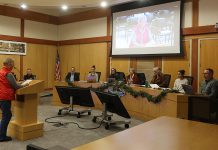
The year 2020 in Sonoma County will be remembered more for the COVID-19 pandemic and series of wildfires, but it also was a year bookended by a persistent homeless crisis that will still exist into the new year of 2021.
Entering this year, the Sonoma County Board of Supervisors allocated emergency homeless funds of $11 million in December 2019 on top of previously budgeted federal funds of $4.7 million. Mid-year, California Gov. Gavin Newsom awarded millions more for COVID-19 homeless responses and for his Project Homekey program to support the local purchases of permanent support housing.
The county government’s multiple programs and responses to the homeless crisis are led by the Community Development Commission and Department of Public Health. Nonprofit agencies such as the north county’s Reach For Home and the west county’s West County Community Services receive some county funding as well as other grants. Homeless programs are coordinated by a Continuum of Care technical team and leadership council. While the clearance of a very large homeless encampment in February at the Joe Rodota Trail attracted the most public attention this year, the fight against homelessness continues to be an everyday effort.
Last week, the county released the long-delayed Point-In-Time Homeless Census Comprehensive Report that showed a 7% decline of the county’s homeless population over the previous year. The report also enumerated who makes up the unsheltered population, counted at 2,745 on the day of the count, Feb. 28, 2020.
County officials and others applauded the downward trend of the homeless population, which hit a high mark in 2011 at 4,539. However a Civil Grand Jury report released in June was critical of the large amounts of spent money without accurate accounting. The jury found “no tracking mechanism” and reported it could “not even make a rough estimate.” In a required response, the county supervisors acknowledged the problem, adding that an accounting plan will be in place in early 2021.
A single homeless person could account for as much as $60,000 to $100,000 a year in consumed health, shelter, support and other services, the grand jury report found. But, of course, no two profiles are alike.
The annual official homeless count in February found that 40% of the population is chronic homeless with multiple years of being unsheltered. Causes for homelessness were loss of jobs (22%), family disagreement (15%), caused by wildfires (10%), substance abuse or mental health issues (22%) and eviction from a rental or property (8%.)
In the count this year, volunteer canvassers and supervisors found that 31% of the population was experiencing homelessness for the first time and that 64% of the counted had lived in Sonoma County for more than 10 years. An overwhelming majority (84%) said they would accept permanent housing if offered but half (52%) had declined other forms of public help.
The north county homeless population was tabulated at 209 (33 in Cloverdale, 38 in Windsor and 69 in Healdsburg.) There were 129 homeless individuals counted in Sebastopol and a total of 327 homeless in west county.
Large portions of the funds spent to address homelessness went to more permanent or longer-term solutions. These included the construction of 60 housing units at Los Guilicos east of Santa Rosa, the purchase of two shelter homes in Santa Rosa, long-term leasing of two indoor/outdoor shelters or camps, hiring of seven additional counselors at the Department of Health and the $6.3 million purchase earlier this month of the Hotel Azura. County funds also support various nonprofit agencies with outreach staff and field services.
In 2021, the county will have as much as $25 million in new homeless and mental health services funds after voters approved a new quarter-cent sales tax in the Nov. 3 election with Measure O.
The Feb. 28 point-in-time count is required annually by the federal Department of Housing and Urban Development to qualify for funding ($4.7 million this year.) The cost of the survey this year was $130,000. The report was assembled by consultants Applied Survey Research and includes almost 70 pages of data, but next to no analysis.
The consultants ended their report with brief comments including, “there are numerous interpretations for the cause of the reported decrease including the continued focus on prevention and housing retention, the successes of coordinated entry, as well as efforts to re-house those who became homeless after the fires. The 2020 Sonoma County Homeless Count and Survey revealed a diverse population with many different trends and needs.”
The census was supported by 215 volunteers.
The next count is expected to take place in early 2021. It is likely the next census count will reflect the dual impacts from the ongoing COVID-19 pandemic and the 2020 wildfires.








